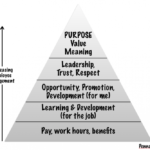Feeling constrained in your business? Try these HR tips…
Constrained is sometimes just a business euphemism for being restricted or ‘stretched’ or in financial terms ‘short of cash’. Deloitte Private Account Director Michael Hyatt shares his HR tips for cash constrained or resource constrained organisations.
Productivity is the key component of business success, particularly in perilous times. Traditional measures of productivity centre on hours worked and widgets per hour but these are just measures they are not drivers of productivity.
So how can businesses raise their productivity and safely navigate commerce given their constraints?
Productivity through alignment is about accountability and eliminating waste and non-value adding activities.
Many businesses are living in a ‘cash constrained’ environment but others, on the other hand, are flushed with cash but are constrained by resources, skills or inefficiencies. The same thing applies: they need to look at productivity which is the common denominator when growth is hampered by economic constraints. We don’t have to look too far to see both sides, with manufacturing and retail getting squeezed and engineering firms struggling to meet demand.
With regards to people, there are some high level questions I like to ask. Are your people clear on what the business wants to achieve? Are their position descriptions clear on what their responsibilities are? How do you measure and reward performance? How effective are your learning and development programs? Are each of these programs aligned to business objectives?
Let’s take a look at learning and development programs; is the training directly focused around raising the skills, capability and competitiveness of the business? If it is not, you are wasting precious resources on activities that will not add value to the business. How many times have you heard the term, haemorrhaging money? Activities not focused around the business could cost you dearly. The common unifying thread throughout your people programs are the alignment with business objectives. This is the yard stick you need to measure against whether an activity is invested in or not. Always ask the question – does this contribute to the bottom line? And when it does, measure how effective it is – if you are not measuring it then you can’t improve it.
In terms of people practices to drive productivity, I recommend creating alignment to drive accountability, creating an innovative culture to drive customer retention and development, increasing employees discretionary effort so they go the extra mile and downsize (if you have to) for growth ensuring you have the kept the right capability.
Creating and developing a culture of innovation is a prerequisite to underpinning a productive culture. Innovation is not simply providing a room with cool stuff in it for some propeller heads to play with, it is moving people from ‘opting in’ to ‘it’s your responsibility’ to innovate. How does one do that? In tough times, innovation must be close to the customer so that it drives revenue, new business and customer retention. The Australian Business Foundation stated that, ‘The kind of innovation that counts is action that transforms Australia’s business capabilities, skills and competitiveness.’ Businesses that focus on improving these three areas through innovation will literally transform their business into a productive powerhouse.
A highly engaged workforce can increase customer loyalty, satisfaction and profit. There is a real need to understand the level of employee engagement so you can develop a more productive workforce. A supportive workforce is not going to cut it anymore, you need a committed workforce. You need to move employees from wherever they are now to commit to your business objectives and willingly put in discretionary effort. They need and want to feel part of the journey. So how do you do that? First thing to do is determine the level of employee engagement, measure it! This will help you to understand the root causes of why people have disengaged: is it cultural, performance management processes, communication, or simply where they fit in? This will inform you where to invest precious resources to create the greatest impact.
According to Deloitte’s Lucky Country business series released in late 2011, effective employee engagement does indeed provide significant business productivity benefits, such as:
- Higher operating incomes, net income growth and earnings per share
- A significant reduction in staff turnover
- Significant savings in skills and training costs
You may well find you may need to ‘right-size’ your workforce to meet your objectives, and regardless of whether you are adding to or reducing your workforce, consideration must be given to who you are adding or letting go, what effect is that having on the people left behind and does it take a toll on productivity?
It can impact and hit productivity when you are letting people go who have great integrity in the workforce so you need to consider the impact of such departures and what you need to put in place to re-engage your workforce.
Another issue is who are you letting go? Are you keeping the right people? Are you looking at the big picture, the business objectives and strategies? Are you building capability, keeping the right skills and creating a more competitive environment? Are the numbers right? So when the uplift comes back, when the economy starts turning around, are you ready to take advantage of that? Or are you going to be left behind scrounging for the scarce resources that are left.
The same mistakes are made over and over again as the economy goes through its different cycles; cutting employee programs and downsizing seems the easy path. Building innovative cultures, improving employee engagement and measuring the effectiveness of these programs are not easy but will stand you in good stead when the harsh times come, and they will.
This opinion piece was first published on Deloitte Private Matters and is reproduced here with the kind permission of the author, Michael Hyatt.



